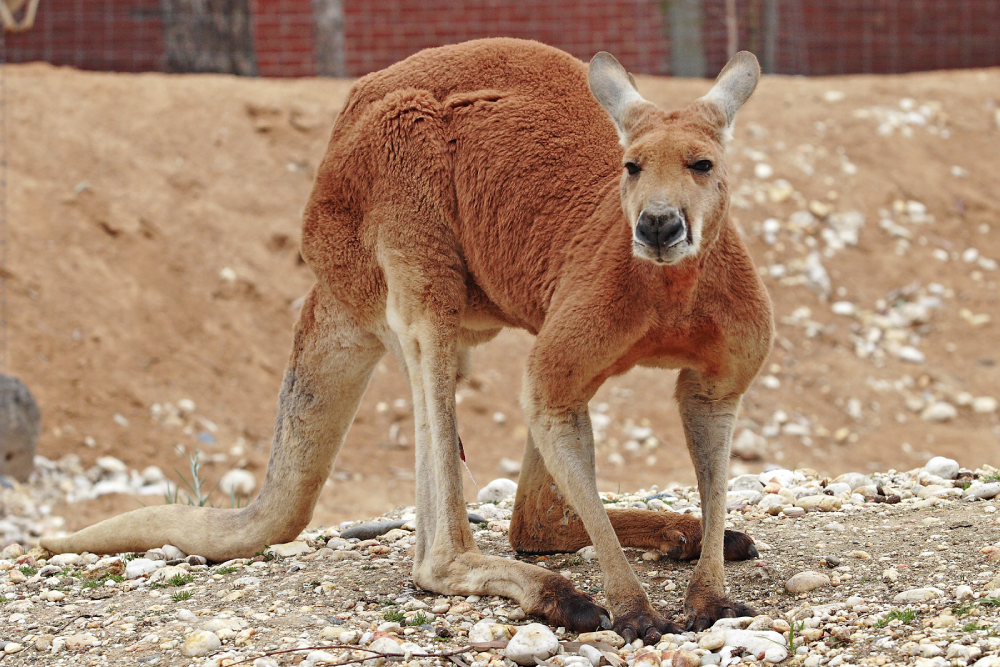Biology and Appearance
The Red Kangaroo’s physical attributes are striking and unmistakable. Known for its reddish-brown fur, muscular build, and elongated face, this marsupial possesses adaptations that enable it to thrive in the harsh Australian environment. Adult males, or bucks, can reach heights of up to two meters (6.5 feet) and weigh as much as 90 kilograms (200 pounds), making them one of the largest marsupials in the world. Females, or does, are generally smaller, with a height of around 1.5 meters (5 feet) and a weight of 35 to 40 kilograms (77 to 88 pounds).
One of the most distinctive features of the Red Kangaroo is its powerful hind legs. These are perfect for rapid acceleration and long-distance hopping. These kangaroos are adept at bounding across the open plains of the Australian outback, reaching speeds of up to 70 kilometers per hour (43 miles per hour). Their long tails serve as a counterbalance, aiding in agility and stability during movement.
Behavior and Social Structure
Red Kangaroos are primarily crepuscular, meaning they are most active during dawn and dusk when temperatures are cooler. During the heat of the day, they seek shelter from the sun in the shade of trees or bushes, conserving energy until the cooler hours return.
These marsupials are generally solitary animals, but they may form loose social groups known as mobs, especially in areas with abundant food and water resources. Mobs typically consist of several females and their offspring, along with one dominant male. The male, known as the alpha or dominant buck, maintains his position through displays of aggression and dominance, particularly during the breeding season, known as the rut.
Breeding and Reproduction
The reproductive cycle of Red Kangaroos has close connections with environmental conditions, particularly rainfall and food availability. Breeding typically occurs throughout the year, but peaks during the wet season when vegetation is abundant. Females have a well-developed pouch, where they nurse and protect their young, known as joeys, for several months after birth.
The gestation period for Red Kangaroos is relatively short, lasting around 30 to 36 days. Once born, the tiny, underdeveloped joey climbs unaided into its mother’s pouch, where it continues to grow and develop for several months. As it matures, the joey gradually ventures out of the pouch, returning to nurse until it is fully weaned, usually around eight to ten months of age.

Habitat and Range
Red Kangaroos are highly adaptable and live in a variety of habitats across mainland Australia, ranging from arid deserts to open grasslands and woodlands. They are particularly abundant in the semi-arid and arid regions of central and western Australia, where they have evolved specialized adaptations for coping with extreme temperatures and limited water sources.
These kangaroos are perfect for the sparse vegetation and dry conditions of the Australian outback, relying on their efficient digestive systems to extract moisture and nutrients from fibrous grasses and shrubs. Their distribution is closely linked to the availability of food, water, and suitable habitat, with populations fluctuating in response to changes in environmental conditions.
Conservation Status and Threats
While Red Kangaroos are not currently listed as endangered, they face several threats to their survival, including habitat loss, competition with livestock for resources, and human-related activities such as hunting and vehicle collisions. In some areas, overgrazing by domestic livestock has led to the degradation of native vegetation, reducing food availability for kangaroos and other native species.
Conservation efforts aimed at protecting the habitat and populations of Red Kangaroos are essential for ensuring their long-term survival. This includes the establishment of protected areas, such as national parks and reserves, where kangaroos can live and breed without disturbance. Additionally, measures to mitigate human-wildlife conflicts, such as wildlife corridors and fencing, can help reduce the risk of collisions and other negative interactions between kangaroos and humans.
Cultural Significance
The Red Kangaroo holds a special place in Australian culture and identity, serving as a national symbol and emblematic of the country’s unique wildlife heritage. Its image adorns various emblems, including the Australian coat of arms, currency, and sports teams, reflecting its status as an iconic Australian icon.
In Indigenous Australian culture, the Red Kangaroo features prominently in Dreamtime stories and art, symbolizing strength, resilience, and survival in the harsh Australian landscape. Traditional hunting and gathering practices have long been intertwined with the presence of kangaroos, with Indigenous peoples utilizing their meat, hides, and bones for food, clothing, and tools.
Conclusion
The Red Kangaroo stands as a testament to Australia’s rich biodiversity and the remarkable adaptations of its native wildlife. From its impressive size and agility to its unique biology and cultural significance, this iconic marsupial continues to captivate the imaginations of people around the world. By understanding and appreciating the role of Red Kangaroos in the Australian ecosystem, we can work together to ensure their conservation and safeguard the future of this beloved species for generations to come.









